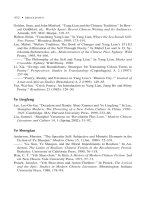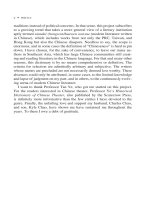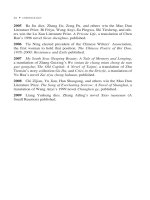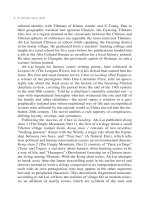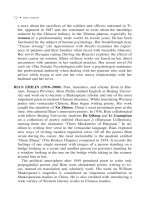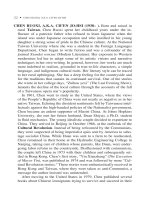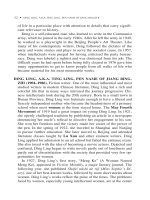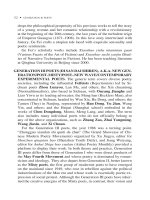"Historical Dictionary of Modern Chinese Literature" by Li-hua Ying - Part 4 ppt
Bạn đang xem bản rút gọn của tài liệu. Xem và tải ngay bản đầy đủ của tài liệu tại đây (90.51 KB, 10 trang )
2 • AH LAI, A.K.A. ALAI
cultural identity with Tibetans of Kham, Amdo, and U-Tsang. Due to
their geographic location and agrarian lifestyle, the Gyarong Tibetans
who live in a region situated at the crossroads between the Chinese and
Tibetan spheres of influences are arguably the most sinicized Tibetans.
Ah Lai learned Chinese at school while speaking the Gyarong dialect
in his home village. He graduated from a teachers’ training college and
taught in a rural school for five years before his publications landed him
a job at the Aba Cultural Bureau as an editor for a local literary journal.
He later moved to Chengdu, the provincial capital of Sichuan, to edit a
science fiction journal.
Ah Lai began his literary career writing poetry, later collected in
Lengmo he (The Lengmo River), but it is his fiction that earned him his
fame. His first and most famous novel, Chen’ai luoding (Red Poppies),
a winner of the prestigious Mao Dun Literature Prize, tells an apoca-
lyptic tale about the final years in the history of the Gyarong-Tibetan
chieftain system, covering the period from the end of the 19th century
to the mid-20th century. Told by a chieftain’s mentally retarded son—a
man with supernatural foresights who has witnessed the rise and fall of
his family and other chieftains—the novel opens a window to a geo-
graphically isolated area whose traditional way of life and sociopolitical
system were affected by the outside world as China moved into the tur-
bulent 20th century. The novel unfolds a rich tapestry of conspiracies,
shifting loyalty, revenge, and romances.
Following the success of Chen’ai luoding, Ah Lai published Kong
shan 1 (The Empty Mountain, Part 1), the first of a trilogy about a small
Tibetan village named Jicun. Kong shan 1 consists of two novellas:
“Suifeng piaosan” (Gone with the Wind), a tragic tale about the friend-
ship between two boys, and “Tian huo” (A Natural Fire), which tells
how political and human intervention causes an environmental disaster.
Kong shan 2 (The Empty Mountain, Part 2) consists of “Dase yu Dage”
(Taser and Tager), a sad story about hunters when hunting ceases to be
a way of life, and “Huangwu” (Desolation) focusing on a Chinese peas-
ant living among Tibetans. With the Kong shan series, Ah Lai attempts
to break away from the linear storytelling used in his earlier novel and
chooses instead to write a trilogy composed of six independent novellas,
each with its own protagonists who may appear in the other segments
but only as peripheral characters. This decentered, fragmented structure,
according to Ah Lai, reflects the realities of village life in modern times.
As an offshoot of nearby towns, which are symbols of the state and
modernity, the village, in Ah Lai’s view, plays no role in choosing its
part in the grand national mission. Unlike the countryside in the heroic
narratives of socialist realism by such writers as Ding Ling, Zhou
Libo, and Hao Ran, the center stage of Ah Lai’s Jicun is not occupied
by a hero tied with the state in one single ideological vision, but rather
by a multitude of small characters, each operating from his or her own
center and taking turns to command attention. The realities of such rural
life are formed by these little “centers,” acting like the small pieces in
a jigsaw puzzle. Ah Lai structures his three Kong shan novels in such
a fashion to reflect the lost or fast disappearing cultures of a mountain
village.
Ah Lai’s other works include Aba Ah Lai (Aba and Ah Lai), a col-
lection of short stories and prose work written in the 1980s and 1990s
about his hometown and his own spiritual odyssey, mingling Tibetan
folklore with real-life stories, and Dadi de jieti (The Earth’s Staircase),
a travelogue that documents the author’s journey across his native land
and contemplates the spirit of the people as outside forces intrude upon
their lives and ravage their environment.
Ah Lai taps the rich source of Gyarong culture to create poignant
and intriguing literary work. His richly detailed narratives about the
specific travails of the region in its recent history invoke Tibetan
folklore and local legends, generating a sense of timelessness infused
by a unique sensibility cultivated from multiple literary and cultural
traditions.
AI QING, PEN NAME OF JIANG HAICHENG (1910–1996). Poet.
Born to a landed family in Zhejiang, Ai Qing was initially trained to be
an artist. In 1929, he went to France to study oil painting and sculpture
and was introduced to Marxism and French poetry. The Japanese inva-
sion of China roused his sense of nationalism. Upon his return from
Europe, Ai Qing joined a group of leftist artists and was later arrested by
the Nationalist government. Unable to paint while in prison, he turned to
writing poetry and was soon recognized as an important poetic voice in
the nation. In 1941, he went to Yan’an, the Communist base at the time,
and became a party member three years later. He moved to Beijing after
the Communist victory. In 1957, he was branded a “rightist” and lived
in exile on remote farms until 1973 when an eye illness brought him
back to Beijing for treatment. In 1979, he was rehabilitated and elected
deputy chairman of the Chinese Writers’ Association.
AI QING, PEN NAME OF JIANG HAICHENG • 3
Ai Qing earned a reputation in the 1930s as a patriotic poet whose
passionate love of the land and its people is expressed in such poems
as “Dayanhe—wo de baomu” (Dayan River My Wet-nurse), “Taiyang”
(The Sun), “Liming” (Dawn), and “Chun” (The Spring). During the
Sino-Japanese War, his poems served as rallying cries for the nation,
which eagerly embraced the nationalist spirit sung in poems such as
“Beifang” (The North), “Xue luo zai zhongguo de tudi shang” (Snow
Falls on the Chinese Land), and “Xiang Taiyang” (To the Sun). Writing
in the vernacular language and free style, Ai Qing made a significant
contribution to modern Chinese poetry. His technique, defined as simple
and straightforward, and his voice, idealistic and sentimental, helped
establish a poetic tradition that lasted throughout the Mao era. See also
MODERNISTS.
AI WU, PEN NAME OF TANG DAOGENG (1904–1992). Fiction
writer and essayist. Born into an intellectual family in a small town of
southwestern China, Ai Wu spent his formative years in the company of
liberal educators and progressive magazines that advocated discarding
China’s traditional culture in order to transform it into a modern na-
tion. To experience the life of the working class, called for by the leftist
movement, Ai Wu left his hometown at the age of 21 and traveled south
to Yunnan and Burma, often in the company of small merchants, horse
thieves, and other such vagrant personalities. The journey became the
source of his most important work, Nan xingj ji (Journey to the South),
as well as the catalyst for his ideological conversion to communism. In
1929, while stranded in Rangoon, he joined the Burmese branch of the
Malaysian Communist Party.
The most memorable characters in Nan xing ji are vagrants who live
on the fringes of society. Life in the picaresque world of border towns
and villages that had attracted Ai Wu proved to be appealing to his read-
ers as well. With the publication of Nan xing ji, Ai Wu was established
as a serious writer of literature. Fengrao de yuanye (Fertile Plains),
Guxiang (My Native Land), and Shanye (Mountain Wilderness), three
novels set against the backdrop of the Sino-Japanese War, explore the
social fabric of the war-torn Chinese countryside and the role morality
and tradition play during the national crisis.
After the establishment of the People’s Republic of China in 1949,
Ai Wu was elected a member of the All-China Federation of Writers
and Artists and served as a council member of the Chinese Writers’ As-
4 • AI WU, PEN NAME OF TANG DAOGENG
sociation. He published Bai Lian cheng gang (The Tempering of Steel),
and Nan xing ji xubian (Sequel to Journey to the South), which extol
ordinary citizens whose sense of collectivism and loyalty to the party
are depicted as the driving force behind Communist China’s success.
During the Cultural Revolution (1966–1976), like many other writers
of his generation, Ai Wu was forced to abandon his writing and was not
allowed to resume it until the end of the turbulent decade. Throughout
his literary career, Ai Wu remained committed to the belief that the re-
sponsibility of a writer was to champion the working class and to create
realist portraits of ordinary men and women.
AN QI (1969– ), PEN NAME OF HUANG JIANGPIN. Poet. Born in
Zhangzhou, Fujian Province, and graduated from Zhangzhou Teachers’
College, An Qi earned her reputation with several collections of poetry,
including Ge: shui shang hong yue (Songs: Red Moon on Water), Ben-
pao de zhalan (Running Railings), and Xiang Dulasi yiyang shenghuo
(Living in the Manner of Duras). Her poems tend to focus on how to tear
down the conventional boundaries of poetic language in order to create
a sense of freedom without having to make sense of the random frag-
ments contained within the lines. The world in her poems lacks struc-
ture, which reflects her perception of reality. The unbridled words and
imageries, especially in the poems written since 1998, are a testament to
the poet’s vivid imagination. An Qi acknowledges her debt in particular
to Ezra Pound, to whom she pays homage with the poem “Pound or the
Rib of Poetry,” and to the Chinese classical novel Hong lou meng (A
Dream of Red Mansions), whose fatalist worldview inspired her to write
“Zai Da Guan Yuan li xiangqi de Zhongjian dai” (The Middle Genera-
tion Reminded in the Grand View Garden) and “Gei Cao Xueqin” (To
Cao Xueqin). In addition to her own creative work, An Qi is known as
a spokesperson for the so-called Zhongjian dai (Middle Generation), a
term coined to promote poets neglected by Generation III proponents,
giving them a distinct identity. She coedited, with Yuan Cun and Huang
Lihai, the anthology entitled Zhongjian dai shi quan ji (Complete Works
by the Middle Generation Poets). An Qi currently lives in Beijing and
edits Poetry Monthly.
AVANT-GARDE (XIANFENG PAI). Influenced by postmodern
literature from Latin America and Europe—particularly works by
Italo Calvino, Jorge Luis Borges, and Gabriel García Márquez—the
Chinese avant-garde movement began in the 1980s and continues to
AVANT-GARDE • 5
the present with abated intensity. Deeply invested in narrative form
rather than content, the avant-garde writers valorize technique and struc-
ture. In a deliberate move away from the realist traditon, they insist that
reality as well as history is highly suspect and unreliable and that it is
personal experience and individual perception that are essential to nar-
rative art. Ma Yuan’s fabrications of Tibetan myths, Can Xue’s night-
marish accounts of individuals’ inner turmoil, Su Tong’s re-creation of
local history, Yu Hua’s grotesque accounts of violence, Ge Fei’s lyrical
prose, Hong Feng’s deconstructed tragedy, and Sun Ganlu’s antifiction
all emphasize irony, ambiguity, dreams and fantasies, multiple reali-
ties, and a highly individual and creative use of language. As a literary
movement, the avant-garde represents one of the two main streams
of contemporary Chinese literature, the other being the root-seeking
movement. There is, however, a tendency found among an increasing
number of writers to merge the two approaches in their works. See also
BEI CUN; CHEN RAN; HAN SHAOGONG; MO YAN; PAN JUN;
SEBO; TASHI DAWA; YAN LI; YU JIAN.
– B –
BA JIN, A.K.A. PA CHIN, PEN NAME OF LI FEIGAN (1904–2005).
Novelist and essayist. Ba Jin was one of the most celebrated and prolific
writers in modern Chinese literature. He grew up in Chengdu, Sichuan
Province, in a large wealthy family. Well versed in the classics, he
nevertheless became an enthusiastic participant in the New Culture
Movement. An anarchist in his radical days, Ba Jin acquired his pen
name from the Chinese transliterations of Mikhail Bakunin and Peter
Kropotkin, two 19th-century Russian anarchists. In the late 1920s, while
studying French social history in Paris, he began a literary career that
would last for more than six decades. Largely known as a fiction writer,
Ba Jin was also a translator, a publisher, and an editor and held many
political as well as professional titles, such as president of the Chinese
Writers’ Association and deputy chairman of the Chinese People’s Po-
litical Consultative Conference. He was the recipient of the Dante Lit-
erature Award (1982) and the Croix de la Légion d’Honneur (1983).
All of Ba Jin’s novels were written in the two decades from the late
1920s to 1947, most notable of which are the trilogies: Jiliu sanbuqu
(Trilogy of Torrent) formed by Jia (Family), Chun (Spring), and Qiu
6 • BA JIN, A.K.A. PA CHIN, PEN NAME OF LI FEIGAN
(Autumn); Aiqing sanbuqu (Trilogy of Love) consisting of Wu (Fog),
Yu (Rain), and Dian (Lightning); and Huo (Fire), also called Kangzhan
sanbuqu (Trilogy of the Anti-Japanese War). Other works published
during this period include his first novel, Miewang (Destruction) about a
depressed young anarchist, and its sequel Xinsheng (New Life), as well
as Qi yuan (Garden of Repose), Disi bingshi (Ward Four), and Hanye
(Cold Night). The protagonists of Ba Jin’s earlier novels are educated
youth caught at the crossroads of tradition and modernity. Jia, generally
considered his finest piece, best represents his works written during this
period. The novel portrays a family in crisis, with the young generation
pitted against the old. The Gao clan mirrors Chinese society, in which
children are demanded by centuries of Confucian tradition to obey the
figure of authority, be it the patriarch or the emperor. Ba Jin points out
in Jia that such a system does nothing but destroy the lives of the young;
the only hope for them is to break free from it.
The Chinese youth at the time readily identified with the passion-
ate heroes Ba Jin created. In contrast with the zealous and optimistic
worldview expressed in his early works, Ba Jin in the 1940s took a
more somber perspective on history, reality, and human nature. Qi yuan
and Hanye are good examples to illustrate the change. Free of the hot-
blooded, idealistic young rebels who populate his earlier novels, these
stories focus on the decline of the old family and the tragic consequences
when hope is dashed by the reality of war, poverty, and prejudice.
In the 1950s and early 1960s, Ba Jin wrote some short stories and
novellas, a few of which were politically motivated and would later be
deemed by the author himself as “waste products.” He suffered a great
deal of physical and psychological abuse during the Cultural Revo-
lution. His best-known work in the post-Mao era is the four-volume
Suixiang lu (Random Thoughts), a collection of essays and memoirs
expressing regrets about the “false and empty words” he had written in
exchange for political protection during the Cultural Revolution.
BAI XIANYONG, A.K.A. PAI HSIEN-YUNG (1937– ). Fiction writer.
Bai Xianyong came from a prominent military family, one of 10 children
of Bai Chongxi (1893–1966), a high-ranking general in the Nationalist
army who served briefly as defense minister in the Nationalist govern-
ment. Bai was born in 1937, in time to experience the Sino-Japanese
War and the Civil War fought between the Nationalists and the Com-
munists. In 1949, while his father was fighting the Communists on the
BAI XIANYONG, A.K.A. PAI HSIEN-YUNG • 7
front, his mother herded the large family first to Hankou, then to Guang-
zhou, and finally to Hong Kong, where Bai attended primary and middle
schools for three years. In 1952, the family was reunited in Taipei with
the father. Bai entered college as a civil engineering major but promptly
switched to English at the National Taiwan University’s Foreign Lan-
guages Department.
The four undergraduate years he spent at National Taiwan University
marked a crucial milestone for Bai and launched his writing career. In
1959, Bai and some of his classmates, all aspiring writers, founded the
bimonthly literary journal Xiandai wenxue (Modern Literature), whose
mission was twofold: to systematically introduce Western modernist
writers including Franz Kafka, James Joyce, Virginia Woolf, William
Faulkner, Jean-Paul Sartre, and Thomas Mann; and to nurture a whole
generation of Taiwan writers. As its editor and frequent contributor,
Bai helped make the journal a trendsetter, leading Taiwan’s literature
into an era of innovation and experimentation. The stories he wrote
and published in Xiandai wenxue are often reminiscences of childhood
and youth, based on and developed from his own life. The first-person
narrator in “Yuqing Sao” (Yuqing’s Wife), for instance, is an observant
little boy who is catapulted into the adult world of illicit passion when
Yuqing Sao, an attractive young widow who is a servant of his family,
kills her lover and herself after she discovers his affair with another
woman.
In 1963, Bai went to the United States to study creative writing
through the International Writers’ Workshop at the University of Iowa.
Two years later with a master’s degree in hand, he accepted a teaching
post at the University of California at Santa Barbara, where he remained
until his retirement in 1994. While in Iowa, he wrote a series of stories
about Chinese expatriates, later collected in a book entitled Niuyueke
(New Yorkers). The reality of life as an expatriate, with it the sense of
dislocation, loss, and memory, is the predominant theme of Niuyueke. In
1973, Bai published Taipei ren (Taipei Characters), the most important
work of his career, winning him a large following in the communities
of the Chinese diaspora. The book has since been reprinted many times
by several publishers, both in Taiwan and on the mainland. The main
characters of Taipei ren are people who followed the Nationalist gov-
ernment to Taiwan. Many of them had enjoyed privileged lives on the
mainland as society dames, generals, government officials, bankers, or
industrialists. Bai examines how the past affects their lives by probing
8 • BAI XIANYONG, A.K.A. PAI HSIEN-YUNG
into their longings, regrets, aching passions, melancholy, and nostalgia.
There is a constant undercurrent of irony in these stories. As he relent-
lessly scrutinizes the complex emotions of his characters, Bai maintains
a cool narrative distance, which enhances the tragic consequences of
their situations. With Taipei ren, Bai has perfected the art of short story
telling and the book displays his unique artistic sensibilities, impec-
cable artistry, and a keen moral vision. Bai has written one novel, Niezi
(Crystal Boys), which depicts the underground world of homosexuals in
Taipei.
Since his retirement, Bai has been devoting his time to reviving and
promoting Kunqu Opera. He travels frequently across the Pacific Ocean
to deliver lectures and speeches in Taiwan, Hong Kong, and China on
literature, dramatic performances, and AIDS awareness. See also MOD-
ERNISTS.
BEI CUN, PEN NAME OF KANG HONG (1965– ). Fiction and screen-
play writer. Bei Cun grew up in Fujian and studied Chinese literature
at Xiamen University. In the early 1990s he was an avant-garde writer,
publishing a series of sketches, including “Taowangzhe shuo” (Says
the Escapee), “Jiechizhe shuo” (Says the Kidnapper), “Pijiazhe shuo”
(Says the Armored), and “Guixiangzhe shuo” (Says the Returnee), all
of which focus on experimenting with innovative narrative techniques.
This stylistic focus was later replaced by an intense interest in explor-
ing the human soul, the meaning of life. Works such as Shixi de he
(The River of Baptism), which depicts a poet’s wandering experience,
“Huanxiang” (Homecoming), an allegorical tale about the tragic fates
of five poets, and “Zuihou de yishujia” (The Last Artist) all examaine
human spirituality in its complicated manifestations. Laomu de qin
(Laomu’s Violin), and “Zhou Yu de hanjiao” (Zhou Yu’s Shouts),
which has been adapted into a movie, further explore the difficulties
encountered in a spiritual journey. Salvation, as shown in the lives of
the protagonists in these stories, lies in the individual’s ability to find
meaning in art/poetry, which proves to be elusive at best in an era of
materialism and commodification.
Since 2003, Bei Cun has published several novels, including Fennu
(Furor) about a young man’s journey from the countryside to the city, from
being an innocent and ambitious man to a criminal who finally comes to
repent his actions while running away from the authorities, and Gonglu
shang de linghun (Souls on Highways), a family saga unfolding in three
BEI CUN, PEN NAME OF KANG HONG • 9
generations, three countries, and three wars, connected by three highways.
Compared with his earlier works, which tend to be dark and gloomy, these
recent novels present life from a more upbeat and idealistic perspective,
despite apparently tragic circumstances. Other than short stories and nov-
els, Bei Cun has written screenplays as well as poetry. He currently works
as an editor for Fujian wenxue (Fujian Literature).
BEI DAO, PEN NAME OF ZHAO ZHENKAI (1949– ). Poet and es-
sayist. Bei Dao is the most notable representative of the Misty poets
associated with the underground journal Jintian (Today), which Bei Dao
cofounded in 1978 with fellow poet Mang Ke. Jintian published works
written by budding young poets who challenged the ideologically driven
socialist realist tradition that had dominated Chinese literature since the
1950s. A Misty poem ordinarily contains oblique imagery and cryptic
syntax. In their experiment with new techniques, the young poets opted
for elusiveness and ambiguity of meaning, intentionally scrambling the
relationship between the signifier and the signified to foreground the po-
etic language. In so doing, they hoped to cleanse the Chinese language
that had been saturated with politics and communist ideology. In their
effort to to remove the dogmatic, cliché-ridden expressions, they strove
to replace the public, official language with a highly individualized one.
Jintian nurtured a whole generation of poets, such as Yang Lian, Gu
Cheng, Duo Duo, and Shu Ting, and helped establish Bei Dao’s posi-
tion as the leader of post-Mao poetry. Bei Dao was a favorite among
college students, and one of his poems, “Huida” (Answer), a rebellious
rejection of blind loyalty, became a battle cry for the prodemocracy
movement in 1989. The activities of Bei Dao and the other Misty poets
came to a halt in the aftermath of the crackdown on the Tian’anmen
protests. Jintian was banned due to accusations of having instigated the
protests, and its leading voices were silenced. Bei Dao, who was attend-
ing a conference in Berlin at the time, was forbidden to return to China.
Jintian was resurrected in Stockholm in 1990 as a forum for expatri-
ate Chinese writers. During his time abroad, Bei Dao has lectured at a
number of universities in the West and his poems have been translated
into several languages.
Bei Dao’s poetry has gone through several phases, from defiant
political outcry to personal ruminations about passion, love, and friend-
ship, to the mourning of the bleak interior world, to ironic examinations
of the human condition. The core of his poetry, however, has remained
10 • BEI DAO, PEN NAME OF ZHAO ZHENKAI
the same: to explore the intricate web of language and the nature of the
self in relation to the emotional wounds inflicted by history and society.
Unlike his hermetic poetry, Bei Dao’s essays are easily accessible. In
them, he offers his thoughts on a variety of topics, such as the stresses
of exile, reminiscences about his friends, and recollections of his life in
China. Bei Dao’s poems and essays written since his exile have earned
even more critical acclaim. For his uncompromised stance in defense
of freedom of expression and his literary achievement, Bei Dao was
inducted into the American Academy of Arts and Letters as an honor-
ary member. He has been repeatedly nominated for the Nobel Prize for
literature.
BI FEIYU (1964– ). A Jiangsu native, Bi Feiyu graduated from Yangzhou
Teachers’ College in 1987. For his depiction of Chinese country life and
his examination of the psyche of the Chinese peasants, Bi is considered
an important newcomer in the root-seeking movement, although he
started his career as an experimental writer. His novella “Gu dao” (The
Solitary Island), in which a family legend intersects with national his-
tory, shows a writer more interested in narrative technique than plot
and story. His later works, including award-winning stories “Buru qi de
nüren” (Women in Lactation) and “Qingyi” (The Opera Singer), depart
from experimentalism and embrace a realist style. Bi’s novels include
Yumi (Yumi), a trilogy about three sisters forced to quickly learn to fend
for themselves when their village party secretary father falls from power
as a result of sex scandals; Pingyuan (The Plain), which explores the
mind-set of the peasants and their hard life in the 1970s, focusing on the
vulnerability and despair of young people; Tuina (Massage), an account
of the ordinary life led by a group of blind masseuses.
BI SHUMIN (1952– ). Fiction writer. Born in Yili, Xinjiang, Bi Shumin
joined the military at 16 upon graduation from the Beijing Foreign
Languages School, where she majored in Russian. Bi spent the next 11
years in Tibet, working in the army first as a nurse, then a medic, and
finally a doctor, until the 1980s, when she finished her military service
and returned to Beijing. To nurture her budding literary interest, she
studied creative writing at Beijing Normal University and received her
master’s in 1991. Later, she returned to the university and received her
Ph.D. in psychology in 2002.
Bi began writing in the 1980s, inspired by her experience in Tibet.
Her first publication “Kunlun shang” (Death in the Kunlun Mountain),
BI SHUMIN • 11
